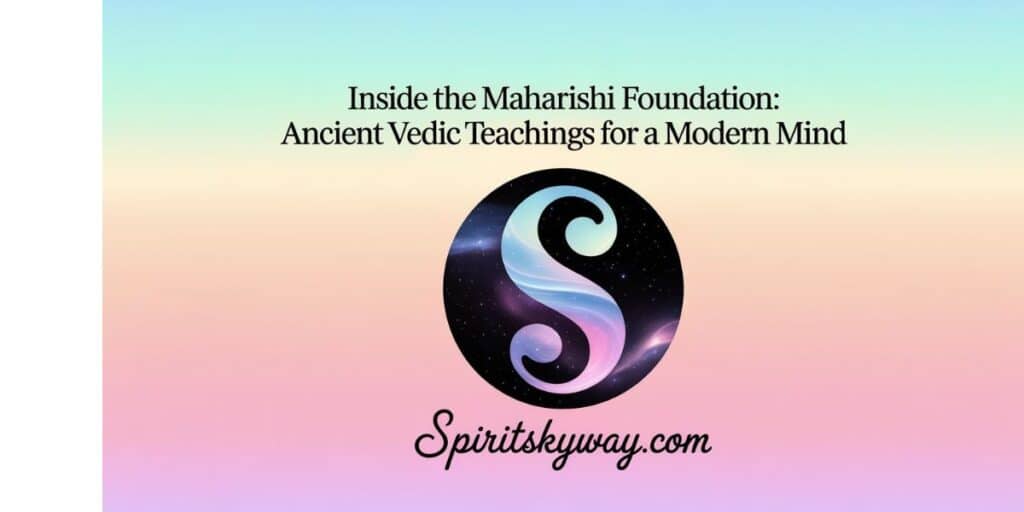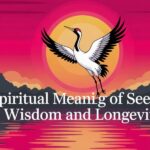Inside the Maharishi Foundation lies deep wisdom.
It blends ancient Vedic teachings with modern thought.
Discover how this modern mind meets timeless truth.
Vedic & Vedas – Definitions and Scope
At its root, Vedas refer to the ancient scriptures born in India’s early wisdom tradition. Those texts—Vedic in nature—span ritual, philosophy and cosmic insight. They form the very cornerstone of a spiritual and cultural universe still alive today.
Must read: Black Carpenter Bee Spiritual Meaning: Resilience
Meanings of ‘Vedic’
The term ‘Vedic’ carries more than simple chronological weight. It signals connection to the Vedas—the language, the worldview, the spiritual ethos. Yet its meaning shifts based on context, from literal reference to profound identity.
Going by the word alone
Taken purely as Vedic, the descriptor points to “of the Vedas.” It evokes meter, verse, archaic Sanskrit roots and sacred hymns. In this literal sense, Vedic is tied strictly to tangible scriptural content.
Going by one or more traditional uses of ‘Vedic’
Traditionally, Vedic extends beyond text. It includes rituals, yajnas, principles of dharma, even schools of thought like Vedanta.
Someone describing a practice as Vedic could refer to ceremony, lifestyle, sound resonance, or philosophical method.
Gradations in the uses of ‘Vedic’
In wider discourse, Vedic shades into layers. At one end sits strict textual fidelity. Then follows broader cultural influence—art, music, family law shaped by Vedic insight.
Finally, in popular use, it suggests spiritual depth or authenticity, even if not directly Sanskritic.
Core Vedic Literature
Much of what Vedic core works represent are ancient hymns or chants. However, they are a multi-layered, complex world made up of sound, ritual, and revelation. These texts do not just inform a tradition; they are its very skeleton.
The Vedas
The Vedas number four, really vast: Rigveda, the Yajurveda, the Samaveda, and the Atharvaveda. Each speaks in its own way to address spiritual and social needs. Together, they create a real panorama for a divine-human dialogue.
The ancient texts classified and subdivided
Each of the old Vedic texts is considered to belong to specific genres-Samhitas, Brahmanas, Aranyakas, and the Upanishads..
This was not some dry generic description, but one that reflected the different layers of human pursuit-action, worship, meditation, and wisdom.
Other Vedic texts
Beyond the main four lie other Vedic texts—commentaries, schools, secret verses. Some remain oral, some forgotten, some woven into daily ritual. They stretch the boundaries of what’s formally “Vedic” while keeping its soul intact.
The Oldest Veda
From all the Vedas, the Rigveda claims to be the oldest. Its thundering and rhythmic hymns tell of the birth of the cosmos, rivers, gods, and humans. How old is it? Perhaps it is more than three thousand years old, and it is still echoing.
The Atharvaveda
Esoteric and seldom orthodox, the Atharva stands as a rebel among the four. It delves into charms, healing, even sorcery, alongside lofty philosophical concerns. Oftentimes ignored, its Vedic character is equally weighted, just a little less predictable.
Brahman as the Source, Veda-limbs and Veda Supplements
At the heart is Brahman, the eternal source from which the Vedas emerge. Around them grow the Vedangas (limbs of Veda)—grammar, ritual, astrology. Then come Veda supplements—texts like Sutras, layered like roots and branches.
Four or Three Vedas in the Puranas
Curiously, some Puranas mention only three Vedas, excluding the Atharva. Was it once marginal, or reserved for different rituals? Over time, all four gained ground—but those early lists raise questions about Vedic hierarchy.
Upaveda
There are many other Upavedas, more practical branches of this holy seed—medicine as Ayurveda; music as Gandharvaveda; warfare as Dhanurveda; and so on. Even though these texts are not directly part of the grand Vedic corpus, they sing the tunes of that sacred source in worldly domains.
Fifth” and other Vedas
Later traditions mention a “fifth Veda” and refer quite often to the Mahabharata or the Ramayana or even the Natya Shastra.
These texts exemplify the Vedic essence in art, story, or drama. Not canonical, but in spirit, they hold on to that all-important Vedic value.
Vedas in Modern and Global Context
The Vedas have now stepped far beyond the ancient Indian sanctuary. Today, they resonate in yoga studios, healing circles, and meditation apps across the globe.
The Vedas today have very much lost their Sanskrit in this modern and global context and speak new languages to fresh minds.
Vedas in the West
In the West, the Vedas were once obscure, wrapped in mystery and mistranslation. But thinkers, seekers, and scholars cracked open the verses. From Emerson to Einstein, the Vedic pulse quietly shaped Western thought.
A 1967 Interview with Maharishi
In a quiet place, in 1967, Maharishi Mahesh Yogi spoke to Western audiences. He did not lecture; gently yet deeply he shared. The interview sowed seeds of Vedic wisdom in minds hungry for something deeper than material success.
Glimpses from Maharishi’s Vedic Teachings
Maharishi’s Vedic teachings weren’t about religion; they were about consciousness. He spoke of natural law, effortless being, and the deep connection between mind and universe. A few minutes with him felt like touching the stillness inside a flame.
Maharishi’s Vedic Science ☼
Through Vedic Science, Maharishi reframed ancient knowledge as something empirical. He introduced terms like Transcendental Meditation, linking the timeless to the testable. This wasn’t mysticism; it was precision in disguise, with the ☼ sun of Veda shining through.
Human Experience and Consciousness
The human experience isn’t just about what we do—it’s how we feel it. Beneath thought and action lies consciousness, a field of awareness too often ignored. The Vedas invite you to explore that field, not just read about it.
You will like: “Tulsi Gabbard and the Spiritual Warrior Archetype: Dharma in Modern Politics”
Self-Knowledge
True self-knowledge isn’t found in books or mirrors. It’s found in silence—in moments when the mind stops chasing. The Vedic path encourages introspection, reminding you that knowing yourself is the first step toward knowing everything else.
The States
Three states of mind-waking, dreaming, and deep sleep-are universally acknowledged. But the Vedas speak of a fourth: Turiya, where pure awareness is untouched by thought or emotion. It’s not an imaginary castle-the experience is life-altering in the way one perceives everything around.
Stress Diseases
Modern life brings pressure, and with it come stress diseases—hypertension, insomnia, anxiety.
The Vedic tradition, through meditation and breath, offers tools not just to manage but to dissolve stress at its roots. The cure begins in stillness.
Some may have to struggle a long time to relax deeply and well
Some don’t find it easy to have tranquility within. Relaxation might seem paradoxical at times but only very real.
That’s why with Maharishi’s program, some easy, soft entry points have been set up-even austere restlessness can be honored and softened.
About Maharishi & His Teachings
Maharishi Mahesh Yogi didn’t introduce new beliefs—he restored old ones in a new light. His teachings centered on natural law, the inner self, and universal peace. He taught that the Vedas weren’t to be worshipped—they were to be lived.
Maharishi Mahesh Yogi
Born in India, trained in silence, Maharishi Mahesh Yogi became a global teacher. He bridged ancient wisdom with scientific curiosity.
With just a mantra and a method, he brought Vedic knowledge into boardrooms, classrooms, and living rooms.
Success in anything is through happiness”
To Maharishi, achievement wasn’t about ambition—it was about joy. He often said, “Success in anything is through happiness,” not the other way around. That one idea flipped a world chasing results into one discovering purpose.
Course-Related Content
Course Description
This training goes into the depths of Vedic wisdom and offers practical techniques and insights.
Its core subjects are consciousness, self-awareness, and spiritual grounding-from the ancient texts to Maharishi’s teachings. With clarity and simplicity, the path unfolds for beginners and seasoned practitioners alike.
Reviews from a Previous Course
Past students have praised the course for being transformative and surprisingly practical. “I expected philosophy; I found peace,” one review said.
From busy professionals to lifelong seekers, the feedback echoes one theme: the Vedic approach works.
Course Leaders
Led by trained Vedic scholars and certified instructors, the course offers more than just lectures. These course leaders bring warmth, precision, and years of personal practice. They don’t preach—they guide.
Philosophical Concepts
Introduction: What are Purusha, Self, and Cosmic Being?
A word of caution before we begin: Purusha, Self, and Cosmic Being are terms that are not interchangeable.
Each denotes its own unique layer of existence according to Vedic philosophy. Understanding these layers helps clarify your nature and what constitutes reality.
What is Purusha?
Purusha is a passive or silent entity that knows no shape. Being eternal, it does not act but permits the act. Vedic thought represents Purusha as that unchanging witness witnessing change behind every moment.
What is the Self?
The Self is your inner essence; it has nothing to do with your personality or your thought flows but refers to that inner, unshakeable core.
In other words, it is the Atman, the spark of the infinite residing in you, as per the Upanishads. The recognition of the Self is the first step toward realization and liberation
What is Cosmic Being?
Cosmic Being is the totality of all life, every form, every mind, every spark of consciousness: the Vedic vision of the cosmos as a living person. It doesn’t mean you’re separate from it; you are it, localized.
How are Purusha, Self, and Cosmic Being different from each other?
Even though they are similar in some way, Purusha, Self, and Cosmic Being differ from one another in their scope of being and function. Purusha, as the silent observer, identifies with itself with just a spark.
On the other hand, the Cosmic Being becomes more and more evident. They are just different reflections of the same truth about what stillness, identity, and totality are.
How can one experience Purusha, Self, and Cosmic Being?
These layers are primarily experienced by meditation, stillness, and inward attention. The first should be self-understanding which would be familiar yet deep.
Then after that, there is recognized Purusha: calm and detached. And finally, it is with the wider understanding of the Cosmic Being revealed not in terms of visions but of unity.
Conclusion
The Maharishi Foundation houses the age-old Vedic learning for the young minds-before establishing a welfare bridge between the universality of wisdom and the forms it assumes today.
That foundation can be considered as restoring some old texts but bringing forth those in the Vedic teachings alive with practical, accessible forms. By infusing an ancient in-depth science understanding into modern technology, they are offering tools for deeper consciousness, relief from stress, and knowing the true self.
From peace and purposefulness to clarity, again the foundation’s message is clear: the ancient Vedas still have answers for the modern mind and allow transforming oneself.
FAQ,S
What are the Vedas?
Ancient Indian texts of spiritual wisdom and rituals.
They form the foundation of Vedic knowledge.
Who was Maharishi Mahesh Yogi?
A modern sage who revived Vedic science.
He introduced Transcendental Meditation globally.
Is this course for beginners?
Yes, no prior knowledge is needed.
It starts simple and gradually deepens.
What will I learn in the course?
Core Vedic concepts, meditation, and self-awareness.
You’ll explore Purusha, Self, and Cosmic Being.
How is this different from yoga classes?
It’s more about inner experience than poses.
You’ll learn philosophy and mind-body integration.

Will Smith is a passionate spiritual writer and explorer, sharing insights on soul growth, inner healing, and the deeper meanings behind dreams, symbols, and emotions. As the voice behind Spirit Skyway, he helps readers connect with higher wisdom through affirmations, spiritual tools, and ancient truths. Will believes that spirituality is not just a practice but a way of life — and invites you to journey inward through the divine skyway of the soul.






